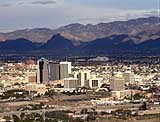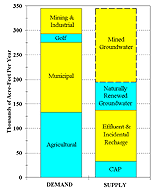
| Preface, v - vi |
Tucsonans face important decisions in the coming months and years that will affect the future of their community. At issue is Tucson’s water supply, the true lifeblood of the area. A topic of vital importance and one that affects every citizen, Tucson’s water supply has long been the focus of controversy. Debates about water issues have caused divisiveness and strife within the community. A major and ongoing source of controversy has been the city’s effort to introduce Central Arizona Project (CAP) water into the city system. This did not go smoothly, and the many problems that resulted from this effort frustrated and angered many citizens. This situation helped create a climate that discouraged constructive community debate and consideration of important water information. Tucsonans now must grapple with the question of how best to ensure a long-term water supply for the community. This involves examining various options, with special attention devoted to finding ways to more effectively use present supplies. Further, if CAP water is to be part of the solution to Tucson’s water supply problem, the community must find the ways and means to use this renewable source that are both affordable and acceptable to Tucson citizens. The many thousands of people who have moved into the Tucson metropolitan area in the past 50 years are using millions of gallons of water daily. Most of that water is “old” water, stored underground for hundreds or thousands of years. Because more “old water” is used each year than is replaced by precipitation, either by rain or snowmelt from surrounding mountains, water tables decline and wells must reach deeper and deeper to tap remaining water. If we do not reduce the amount of water we use and/or unless we utilize a new dependable supply, we will suffer the consequences of our excessive reliance on groundwater. These include the increased cost of pumping from greater depths, decreased water quality and the occurrence of subsidence which can threaten structures, homes, streets and utilities.
Figure 2 shows major water demand categories and sources of water supply for the Tucson area. What is readily apparent is that municipal uses represent the greatest demand and mined groundwater is our primary water source.
Our largest new water source is the CAP which brings water from the Colorado River. Because first efforts to introduce CAP water in Tucson met with serious problems, a majority of voters subsequently rejected its use in their homes unless certain conditions were met. Tucson Water, Tucson’s largest water utility, is making efforts to meet those conditions. When contemplating CAP water use the public needs to understand how its use will affect their homes and lives and the costs involved to minimize any adverse impacts. Tucsonans could then better evaluate CAP options compared to other kinds of water management actions. Other community water issues also need attention. For example: Who should help pay to prolong the usefulness of the aquifer? Should this be the obligation of all water users or just those users who actually use alternative supplies such as CAP and effluent? Should the mines and farms be required to use CAP water or at least help pay for it? Other management issues that need addressing include: Should all Tucson Water customers have a say in Tucson Water policy? Should there be more comprehensive basin-wide management of water supplies? Should there be further limits on total water use? The report notes areas where information for making necessary decisions is lacking. The authors do not recommend any solution, but instead have presented facts and information to assist citizens and decision-makers. As is evident from its title, this publication is about the sustainability of our water resources. Sustainability is a popular word nowadays, often heard when natural resources is the topic of discussion. Used in varied contexts, in government reports, academic journals and the popular press, sustainability is not easily summarized in a one-size-fits-all definition. One point of shared understanding, however, is that sustainability is a desirable goal.
|

